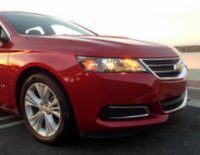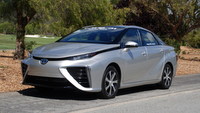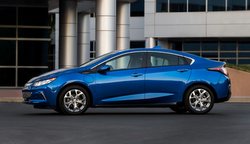An Array of Choices Are Available
With environmental concerns and economic worries, many people have made the decision to buy green vehicles. Cars that are labeled “green” are either those that are environmentally friendly and provide less harm to the environment than similar internal combustion engine cars or those that use alternative fuels.
Purchasing and driving a green car provides a few benefits to both the driver and the environment. First of all, green cars leave a smaller carbon footprint on the environment by releasing fewer emissions. In addition to keeping the air cleaner, these vehicles also offer better gas efficiency, sometimes better than 40 miles per gallon, and a lower lifetime cost for the car. Although the initial purchase price may be higher for a green car, owners often receive government incentives, and the benefits of buying less gas make this car a more economical choice over time.
When choosing to purchase a green car, a new buyer must first evaluate his or her vehicle needs and budget to determine the best type of car. Next, a buyer should consider the vehicles with the highest green scores among cars and trucks that meet his or her requirements, taking into account fuel efficiency and emissions.
There are a few different categories of green vehicles that should be considered in any car purchase.
Clean Diesel Cars

A combination of cleaner, ultra-low sulfur diesel fuel, advanced engines and effective emissions control, results in clean diesel cars that achieve nearly zero emissions. These vehicles typically burn less fuel overall, which means that the cost per mile of driving a clean diesel vehicle is lower than that of typical cars.
In addition to less fuel burned and lower gas costs, clean diesel is also responsible for fewer greenhouse emissions per mile in comparison to normal gas-powered cars. This distinction is important because many modern diesel engines are currently under intense scrutiny by the Environmental Protection Agency (EPA) and other governing bodies after Volkswagen was found to have cheated federal emissions tests since 2009.
Additional “green” diesel options are renewable diesel fuel and biodiesel, which offer a renewable and clean-burning replacement fuel for traditional diesel. Most diesel engines can run on these bio-based diesel fuels with little modifications needed, although buyers should note that biodiesel cannot be used other than in low blends (5 to 20 percent) in most modern diesel vehicles. Renewable diesel, because it meets the same specification as petroleum diesel, can be run at higher blends.
Although clean diesel and bio-based diesel vehicles are more expensive than traditional gas-powered vehicles, their total cost of ownership is usually lower. They offer their owners the possibility to drive many highway miles thanks to their excellent gas mileage and torque.
Natural Gas Cars
Natural gas vehicles run on Compressed Natural Gas (CNG), which is mostly methane stored at high pressure. It is generally considered that they produce fewer greenhouse gas emissions than

most cars with traditional engines. However, buyers should note that since methane is a high GHG pollutant, this potentially negates the tailpipe emissions benefits of CNG when upstream emissions are considered.
While many consider natural gas vehicles to be greener and better for the environment than gasoline-powered vehicles, they face several obstacles that make them less popular. There are very few natural car options for consumers to choose. Natural gas is mostly used to power work trucks, while the only car model currently available is bi-fuel Chevy Impala. Much of this market stagnation is because fuel is difficult to find, and the vehicles do not always perform the same as those using traditional gasoline.
In addition, some drivers see using such natural gas as fuel as unethical due to the use of fracking to obtain the fuel. When hydraulic rigs pump water and chemicals down into an oil or gas well, high pressure is created that forms cracks in the rock protecting the underground oil or gas. Once those rocks are cracked open, the resources can be recovered more easily. The process itself has caused controversy because it has led to horizontal drilling rather than vertical, putting water sources and areas sitting on top of these horizontal lines at risk. Because of this unsafe practice, some eco-conscious consumers are opposed to using natural gas vehicles.
Hydrogen Fuel Cell Vehicles (FCVs)

A type of vehicle that relies on a fuel cell system rather than a traditional engine is known as a fuel cell vehicle (FCV). These vehicles use a combination of hydrogen and oxygen to power an electric motor. Because FCV technology is still relatively new in its automotive applications, there are currently only a few vehicle models available for purchase, and they are only available in limited areas where a fueling infrastructure is available.
Like other electric vehicles, these have no smog or greenhouse gas tailpipe emissions; however, there may be pollutant emissions that come from the process of producing and transporting hydrogen fuel to the vehicle. It does not take long to fill a hydrogen vehicle, but the new technology has not yet resulted in many public hydrogen filling stations, making the use of this type of car difficult at this time.
Hybrid Cars
Hybrid cars developed as a nice fuel combination for those who are interested in improving a vehicle’s environmental impact while also having the ease of a traditional car. Hybrids contain both a gas engine and an electric motor, and usually the vehicle’s system chooses which is used at which time to propel the car.

Because of their ability to use electricity, hybrids are able to cut fuel consumption in comparison to many of their gasoline-only competitors. The use of electricity also means that pollution and emissions can be reduced.
Whereas hybrids were once seen as a cutting-edge vehicle option, purchasing a hybrid today is a relatively conservative choice. The longer time on the market has made hybrid cars reliable. They essentially work like a traditional car, so most mechanical issues have been resolved and many mechanics know how to repair them. There are no major lifestyle changes necessary in order to purchase or drive a hybrid vehicle.
The initial purchase price of a hybrid car can be more expensive than a gas-only vehicle because of the more sophisticated technology involved. While these cars can pay for themselves in time based on the number of miles the buyer drives, some may never fully recoup the purchase price. However, hybrids are an excellent choice for people who want a simple, well-established green car with few lifestyle changes.
Plug-In Hybrids
A plug-in hybrid car usually uses both the gas and electric motor to turn its wheels, either at different times or together. The electric motor uses rechargeable batteries that can be plugged in to

recharge. This method of powering the vehicle allows the car to run for many miles efficiently and inexpensively until the batteries are run down. At that point, the driver has the option to refuel at a gas station if necessary to continue driving.
Many of the same issues that plague electric cars hinder the popularity of plug-in hybrids as well. Although the number of plug-in hybrid vehicles is constantly growing, there are currently only few of these vehicles available. This makes it difficult to shop for and purchase one, and tax incentives are at a lower rate than for pure electric cars. The initial purchase price of a plug-in hybrid is typically lower than that of an electric car because the battery pack is somewhat smaller. These are nice vehicles for car owners who are not ready for an electric car, but who are interested in a green alternative.
Electric Cars

Electric cars run purely on electric motors, or more specifically on electricity stored in their rechargeable batteries or another energy storage option.
As with many green vehicles, there are some financial incentives for purchasing an electric car. Depending on how far the car is driven daily, it may only need to be plugged in and charged at home each night. In that case owners might need 240-volt charging equipment to keep the vehicle ready to drive daily. With fewer moving parts than gas cars, servicing an electric car is usually more affordable.
Buyers should keep in mind that electric cars are more expensive than gas-powered cars, and that there are not that many recharging stations available nationwide. However, their appeal will certainly increase over time as supportive infrastructure for electric cars increases and prices come down. At this time, electric vehicles are best suited for buyers who are committed to making an environmental difference and to dealing with the driving and charging limitations.
Conclusion
The choice of which green car to buy really comes down to the preferences and the lifestyle of the buyer. Deep-green buyers who want zero emissions should choose an electric car charged with solar electricity or some other type of low-carbon power source, such as hydroelectric or wind power. Light-green buyers may be more interested in gas-only vehicles that get high miles-per-gallon gas mileage using new technologies like advanced transmissions, improved aerodynamics and turbochargers.
Although many of these alternative energy cars began as niche products, interest in them has expanded quickly due to federal emissions regulations and policies, as well as an overall awareness of the need to protect the environment from damaging vehicle emissions. As more car buyers continue to turn to green choices, more environmentally friendly designs and productions will become necessary from the automakers.
Related Stories You Might Enjoy:
Road Test: 2016 BMW 328d xDrive Sportswagen
Road Test: 2016 Chevrolet Impala Bi-Fuel
First Drive: 2016 Toyota Mirai
Unveiled: 2016 Toyota Prius
Road Test: 2017 Chevrolet Volt
Road Test: 2016 Nissan Leaf

Although the natural gas cars are environment friendly but it give you limited speed while driving which most of the drivers don’t like.
@Anthony,
Not sure what you mean by “limited speed” with NG vehicles. A well-tuned engine should be able to give you performance comparable to a gasoline car. The biggest catch is it won’t take you as far. The energy density of NG means that on a comparable gallon basis, you will go less far than you would on gasoline. –ed.